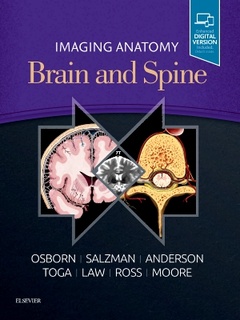Imaging Anatomy Brain and Spine

This richly illustrated and superbly organized text/atlas is an excellent point-of-care resource for practitioners at all levels of experience and training. Written by global leaders in the field, Imaging Anatomy: Brain and Spine provides a thorough understanding of the detailed normal anatomy that underlies contemporary imaging. This must-have reference employs a templated, highly formatted design; concise, bulleted text; and state-of- the-art images throughout that identify the clinical entities in each anatomic area.
- Features more than 2,500 high-resolution images throughout, including 7T MR, fMRI, diffusion tensor MRI, and multidetector row CT images in many planes, combined with over 300 correlative full-color anatomic drawings that show human anatomy in the projections that radiologists use.
- Covers only the brain and spine, presenting multiplanar normal imaging anatomy in all pertinent modalities for an unsurpassed, comprehensive point-of-care clinical reference.
- Incorporates recent, stunning advances in imaging such as 7T and functional MR imaging, surface and segmented anatomy, single-photon emission computed tomography (SPECT) scans, dopamine transporter (DAT) scans, and 3D quantitative volumetric scans.
- Places 7T MR images alongside 3T MR images to highlight the benefits of using 7T MR imaging as it becomes more widely available in the future.
- Presents essential text in an easy-to-digest, bulleted format, enabling imaging specialists to find quick answers to anatomy questions encountered in daily practice.
- Includes the Expert ConsultT version of the book, allowing you to search all the text, figures, and references on a variety of devices.
Brain
Scalp, Skull, and Meninges
Scalp and Calvarial Vault
Cranial Meninges
Pia and Perivascular Spaces
Supratentorial Brain Anatomy
Cerebral Hemispheres Overview
Gyral/Sulcal Anatomy
White Matter Tracts
Basal Ganglia and Thalamus
Other Deep Gray Nuclei
Limbic System
Sella, Pituitary, and Cavernous Sinus
Pineal Region
Primary Somatosensory Cortex (Areas 1, 2, 3)
Primary Motor Cortex (Area 4)
Superior Parietal Cortex (Areas 5, 7)
Premotor Cortex and Supplementary Motor Area (Area 6)
Superior Prefrontal Cortex (Area 8)
Dorsolateral Prefrontal Cortex (Areas 9, 46)
Frontal Pole (Area 10)
Orbitofrontal Cortex (Area 11)
Insula and Parainsula Areas (Areas 13, 43)
Primary Visual and Visual Association Cortex (Areas 17, 18, 19)
Temporal Cortex (Areas 20, 21, 22)
Posterior Cingulate Cortex (Areas 23, 31)
Anterior Cingulate Cortex (Areas 24, 32, 33)
Subgenual Cingulate Cortex (Area 25)
Retrosplenial Cingulate Cortex (Areas 29, 30)
Parahippocampal Gyrus (Areas 28, 34, 35, 36)
Fusiform Gyrus (Area 37)
Temporal Pole (Area 38)
Inferior Parietal Lobule (Areas 39, 40)
Primary Auditory and Auditory Association Cortex (Areas 41, 42)
Inferior Frontal Gyrus (Areas 44, 45, 47)
High-Resolution Cortical Anatomy
Brain Network Anatomy
Functional Network Overview
Neurotransmitter Systems
Default Mode Network
Attention Control Network
Sensorimotor Network
Visual Network
Limbic Network
Language Network
Memory Network
Social Network
Infratentorial Brain
Brainstem and Cerebellum Overview
Midbrain
Pons
Medulla
Cerebellum
Cerebellopontine Angle/IAC
CSF Spaces
Ventricles and Choroid Plexus
Subarachnoid Spaces/Cisterns
Skull Base and Cranial Nerves
Skull Base Overview
Anterior Skull Base
Central Skull Base
Posterior Skull Base
Cranial Nerves Overview
Olfactory Nerve (CNI)
Optic Nerve (CNII)
Oculomotor Nerve (CNIII)
Trochlear Nerve (CNIV)
Trigeminal Nerve (CNV)
Abducens Nerve (CNVI)
Facial Nerve (CNVII)
Vestibulocochlear Nerve (CNVIII)
Glossopharyngeal Nerve (CNIX)
Vagus Nerve (CNX)
Accessory Nerve (CNXI)
Hypoglossal Nerve (CNXII)
Extracranial Arteries
Aortic Arch and Great Vessels
Cervical Carotid Arteries
Intracranial Arteries
Intracranial Arteries Overview
Intracranial Internal Carotid Artery
Circle of Willis
Anterior Cerebral Artery
Middle Cerebral Artery
Posterior Cerebral Artery
Vertebrobasilar System
Veins and Venous Sinuses
Intracranial Venous System Overview
Dural Sinuses
Superficial Cerebral Veins
Deep Cerebral Veins
Posterior Fossa Veins
Extracranial Veins
Spine
Vertebral Column, Discs, and Paraspinal Muscle
Vertebral Column Overview
Ossification
Vertebral Body and Ligaments
Intervertebral Disc and Facet Joints
Paraspinal Muscles
Craniocervical Junction
Cervical Spine
Thoracic Spine
Lumbar Spine
Sacrum and Coccyx
Cord, Meninges, and Spaces
Spinal Cord and Cauda Equina
Meninges and Compartments
Vascular
Spinal Arterial Supply
Spinal Veins and Venous Plexus
Plexi and Peripheral Nerves
Brachial Plexus
Lumbar Plexus
Sacral Plexus and Sciatic Nerve
Peripheral Nerve and Plexus Overview
Anne G. Osborn, MD, FACR, is a University Distinguished Professor and Professor of Radiology and Imaging Sciences and
William H. and Patricia W. Child Presidential Endowed Chair in Radiology at the
University of Utah School of Medicine in
Salt Lake City, Utah
Karen L. Salzman, MD, FACR, is Professor of Radiology and Imaging Sciences. She is the Neuroradiology Section Chief and Associate Fellowship Director, and holds the Leslie W. Davis Endowed Chair in Neuroradiology at the University of Utah School of Medicine in Salt Lake City, Utah.
Arthur W. Toga is the Director, Laboratory of Neuro Imaging, Director, Institute of Neuroimaging and Informatics, Provost Professor, Departments of Ophthalmology, Neurology, Psychiatry, and the Behavioral Sciences, Radiology and Engineering at the Keck School of Medicine of USC. His research is focused on neuroimaging, informatics, mapping brain structure and function, and brain atlasing. He has developed multimodal imaging and data aggregation strategies and applied them in a variety of neurological diseases and psychiatric disorders. His work in informatics includes the development and implementation of some of the largest and most widely used databases and data mining tools linking disparate data from genetics, imaging, clinical and behavior, supporting global efforts in Alzheimer's disease, Huntington's and Parkinson's disease. He was trained in neuroscience and computer science and has written more than 1,000 papers, chapters and abstracts, including eight books. Recruited to USC in 2013, he directs the Laboratory of Neuro Imaging. This 110-member laboratory includes graduate students from computer science, biostatistics and neuroscience. It is funded with grants from the National Institutes of Health grants as well as industry partners. He has received numerous awards and honors in computer science, graphics and neuroscience. Prior to coming to USC he was a Distinguished Professor Neurology at UC
Date de parution : 07-2020
Ouvrage de 928 p.
21.5x27.6 cm



